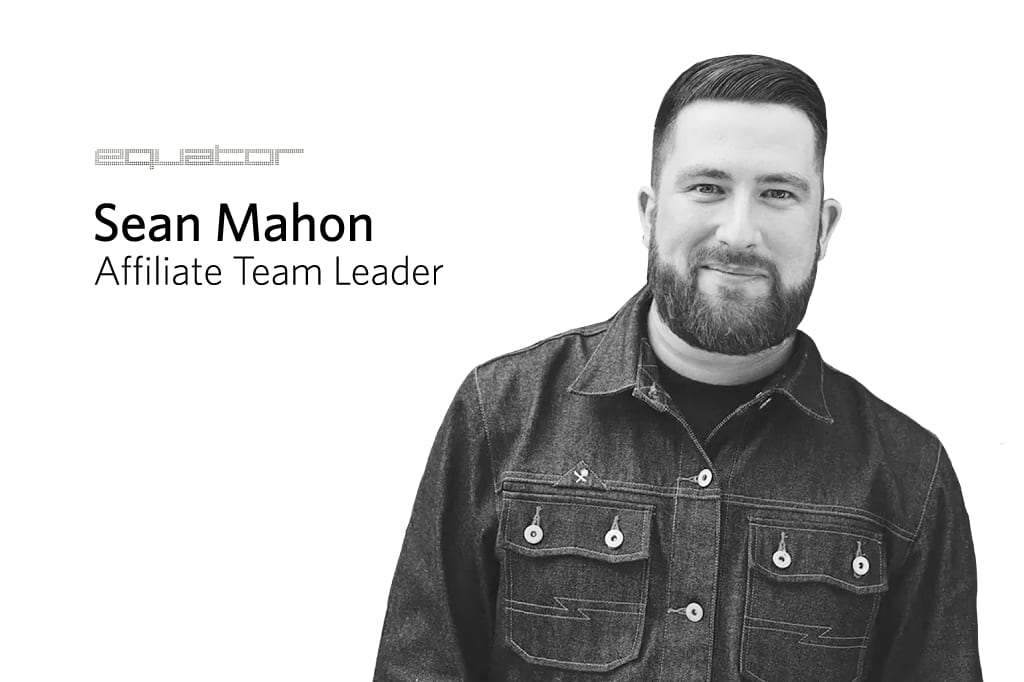Where affiliate marketing sits within the wider digital mix
Written by Robert Davinson on 11 minute read
In his chapter for The Awin Report 2019, Seán Mahon from Equator shares how to secure affiliate marketing as an integral part of the wider digital mix.

Any digital marketer who has been in the game for a minute will be familiar with the tried and tested conversion funnel that has appeared in many a PowerPoint deck over the years.
Affectionately referred to as the ‘conversion toilet’ amongst my peers, the diagram posits that the likes of display sit at the far end of the funnel generating awareness, whereas affiliates tend to sit way down the other end, just before a customer initiates a purchase or action.
You could argue that such an oversimplification of the various channels has caused more harm for both than good over the years. Affiliates in particular tend to get painted as the bad guys in this scenario, jumping out last minute like digital highwaymen, ready to steal the limelight and reward from other channels.
Of course, if you’ve been to any affiliate conference over the last decade or so then you’ll know there are literally hundreds of companies out there who will sell you the ideal attribution solution to combat this situation. But rather than focus on the granularities of what each channel does at each stage prior to conversion, I will instead focus on the evolved role of affiliate marketing in the wider digital mix.

When former ASOS chief executive Nick Robertson infamously made his ‘grubby little affiliates’ comment back in 2007, it betrayed an ignorance of the channel that I would argue still exists to this day. “...but aren’t affiliates just all cashback and voucher code sites???” is an exasperated cry that can still be heard in boardrooms up and down the country. For those of us who work in the industry, this may be cause to collectively roll our eyes. However, I believe it is our duty to educate such misinformed views and demonstrate the importance of the channel within a wider context.
Over the years, I believe this has been the key aspect sorely lacking from the conversation. You could argue that intentionally muddying the waters and obscuring data had been a rewarding approach up until a point for a lot of people involved in digital marketing.
You need only look at the recent ad fraud scandals, or dubious actions perpetrated by the likes of Facebook for evidence of this. That’s why at Equator we looked to restructure our digital marketing team to combat such misinformation. The way I see it, our clients spend X and get Y. The Y that is in their tills when all is said and done does not change regardless of assisted sales, or whatever attribution method we adopt.
Not to diminish the importance of understanding the interplay between channels, but we have to be realistic too. If we are reporting into a client team made up of finance, marketing and/or revenue-focused team members, we need to speak in clear terms that everyone understands. Intentionally confusing the matter, or trying to obscure the data, benefits no one in this situation.
In an effort to tackle this, we set about restructuring our digital marketing team as follows:
- Search (SEO, PPC)
- Digital Media (Display, Email, Social)
- Partnerships (Affiliates, Lead Generation, Outreach)
Rather than allow channels to exist in silos, or group them by association within the outdated conversion funnel, we sought to bring together teams based on their complementary purposes.
Whether it is to own the search landscape, raise the profile of our clients, or build relationships on their part; each of the teams at Equator has a defined purpose. This restructuring has helped immensely for our clients as it not only clarifies our intent and purpose, but also demonstrates how flexible the channels can be when you take them out of their silos or any previously associated place our clients may have held them to on the path to conversion.
Take, for example, the Partnerships team. Traditionally, Outreach existed as an extension of our SEO team. However, through closer working with my Affiliates team, we identified a commonality in skillsets and approaches. How the Outreach team built relationships with sites in order to pursue their link-building activity, was all too similar in approach to how my team forges relationships with prospective publishers.
Indeed, identifying this similar approach helped form the initial conversations about joining the teams up. By collaborating, we benefitted not only from sharing knowledge and skills, but also from growing the team’s resources and ability to tackle work from existing and prospective clients.
Here are just a few examples highlighting the work we have done to rethink the role of affiliate marketing in this wider digital mix following this new internal configuration:
Cost model
The traditional CPA affiliate cost model is arguably the channel’s defining characteristic. You could argue that the relative safety net of only paying for the sales you make is what got affiliate marketing in the door with a lot of brands in the first place.
However, in an ever-evolving marketplace, we can’t always rely on this tried-and-tested method to get the result we want. Especially when working closely with the likes of influencers and bloggers, we are finding that we need to really listen to what works best for them on a case-by-case basis.
A good example of this is how we utilise tools such as Awin’s Opportunity Marketplace to identify suitable content partners for one of our hotel clients. Using this tool to initiate conversations with suitable bloggers, we can arrange alternative payment models (e.g. a comped room) in exchange for an agreed piece of work (e.g. a sponsored write-up for our hotel client). We can then work with our Outreach team to ensure the link placement in subsequent blog pieces is optimal and that the client is satisfied.
We have also used non-traditional cost models to help develop the wider Partnerships team here at Equator. We have educated the Outreach team on how commission-based models work and they are now looking to utilise these in order to trial new approaches with prospective link-building opportunities.
I think overall our approach is changing for the better – it is less about the strict payment models traditionally associated with isolated channels, and more about understanding what works best for our partners and tailoring our approach to be flexible and dynamic.
Contact lists
Ask any affiliate manager what they consider to be their most useful asset and they will likely respond that it is their contact list. Having a trusted pool of affiliate partners is key to your success and the ability to pick up the phone and speak to them when you are in a jam is both a) lifesaving and b) one of the most defining aspects of the affiliate industry that sets it apart from other channels.
Over the years we have cultivated an extensive list of affiliate partners we can rely on, covering a vast array of sectors and territories. By joining forces with the Outreach team here at Equator, we have managed to pool our resources into what we have affectionately termed our ‘little black book of Partnerships’. This means we have a go-to list of trusted contacts to connect with whenever the situation requires.
Upskilling
One of the key activities encouraged on the Partnerships team is upskilling. As much as we might be seasoned pros when it comes to affiliate marketing, it is of huge benefit to us to learn how to write optimised content properly, how to set up a Paid Search campaign, or understand how to traffic a programmatic campaign.
This has been enormously beneficial in expanding our knowledge beyond well-versed affiliate marketing techniques and practices. Likewise, we have been able to work with the Outreach team in order to grow their knowledge of the affiliate channel and really draw upon the networking and relationship-building skills they already possess.
I think this two-way method of communication and learning is essential for any dynamic marketing team. It keeps people learning and constantly innovating in their everyday working practices.
Ok, so the practices outlined above have all been beneficial for the team here in expanding our knowledge and skillsets, but what are the benefits for our clients?
What we are finding more and more, is that strategies are being borne out of open discussion and involvement from all relevant parties. Rather than responding with channel-led suggestions and assigning siloed solutions, we are listening to the client’s requests and breaking it down into the simplest of terms. What is the key objective for the campaign? What are the desired results?
By simplifying our approach, we are encouraging a more open dialogue with our clients and not getting bogged down in isolated approaches and granular levels of channel detail. This is not to say our clients don’t care about the nitty gritty of how our campaigns are run, but this collaborative approach is ensuring greater buy-in across the board.
It may sound like I’m trying to bury the role of affiliate marketing into the modern digital marketing mix by intentionally blurring the lines between the channels, but I wholeheartedly believe that this is the right approach for moving the channel forward. The risk of continually isolating channels and assigning them a predetermined function is that it reinforces this siloed mind-set that tries to block outside influences.
The modern digital landscape is ever-changing and we cannot afford to take a blinkered approach to our supporting marketing efforts. Adopting an open-minded cross-channel approach is paramount. If we want to break the stigma that affiliate marketing is ‘just all voucher code and cashback sites’, then we need to demonstrate that the channel is flexible and dynamic enough to flourish in the modern marketing mix.
The backbone of what makes affiliate marketing unique – the relative safety net of a commission-based payment model and the ability to pick up the phone and actually talk to people, may seem like an outdated notion in 2019. However, I believe this is still fundamental to how we operate in the channel and can be of enormous benefit when aligned with other channel activity.
While I am absolutely advocating for multichannel approaches to digital marketing and encouraging cross-channel learnings whenever possible, I think it also important to not lose sight of what makes our channel special in the first place.
I mentioned earlier how the initial CPA affiliate model was the foot in the door for many programmes, but I think one defining asset of affiliate marketing, that is still relevant today, is the human touch.
I recently attended a spirited discussion with a cross-section of merchants, publishers and network staff around the theme of ‘the marriage of service and technology’ and what impact AI and automation will potentially have on the affiliate industry in the near future. I think the overarching feeling from these discussions was that while our industry has always been quick to embrace innovation and new technology, this has always been underpinned by a human connection at some point in the process.
This enduring fact is one of the building blocks our industry has been built on. When I think back on all my greatest achievements and failures over the past decade working in the UK affiliate industry, I can remember clearly the phone calls, Skype sessions and meetings I’ve had that accompanied them.
The relationships I’ve built over the years as a result of these experiences are undoubtedly the most rewarding aspect of the job. For me, the ability to get things done quickly by picking up the phone and speaking to someone will always have a place in the modern marketing workplace.
Whilst the technology and innovation enabling us to achieve our results will continually evolve, the initial impulse and driving force behind this will always be characterised by our ability to reach out and communicate directly.
This is what we should be emphasising when we are looking for buy-in to affiliate marketing across the board, whether from the client themselves or with your own team internally.
I once heard of a luxury brand who were fundamentally set against affiliate marketing and did not want to be seen to be participating in the channel. Legend goes that the agency involved at the time simply rebranded the channel as ‘paid partnerships’ and, voila! Everybody’s happy! Now, this might read as intentional misdirection as I’ve outlined earlier in this article, but I think that regardless of what we label our affiliate marketing efforts as, we should let them speak for themselves.
Let us demonstrate how quickly we can set things up on a client’s behalf and negotiate placements in their favour. Let us show how flexible our channel can be by securing exposure with relevant partners of all shapes and sizes. Let us show the incremental growth this activity drives and measure the overall ROI against other channels. This will be what secures affiliate marketing’s integral place in the digital marketing mix of today and beyond.
Want more affiliate marketing insights from over 80 contributors around the globe? Download The Awin Report 2019 in full here.



